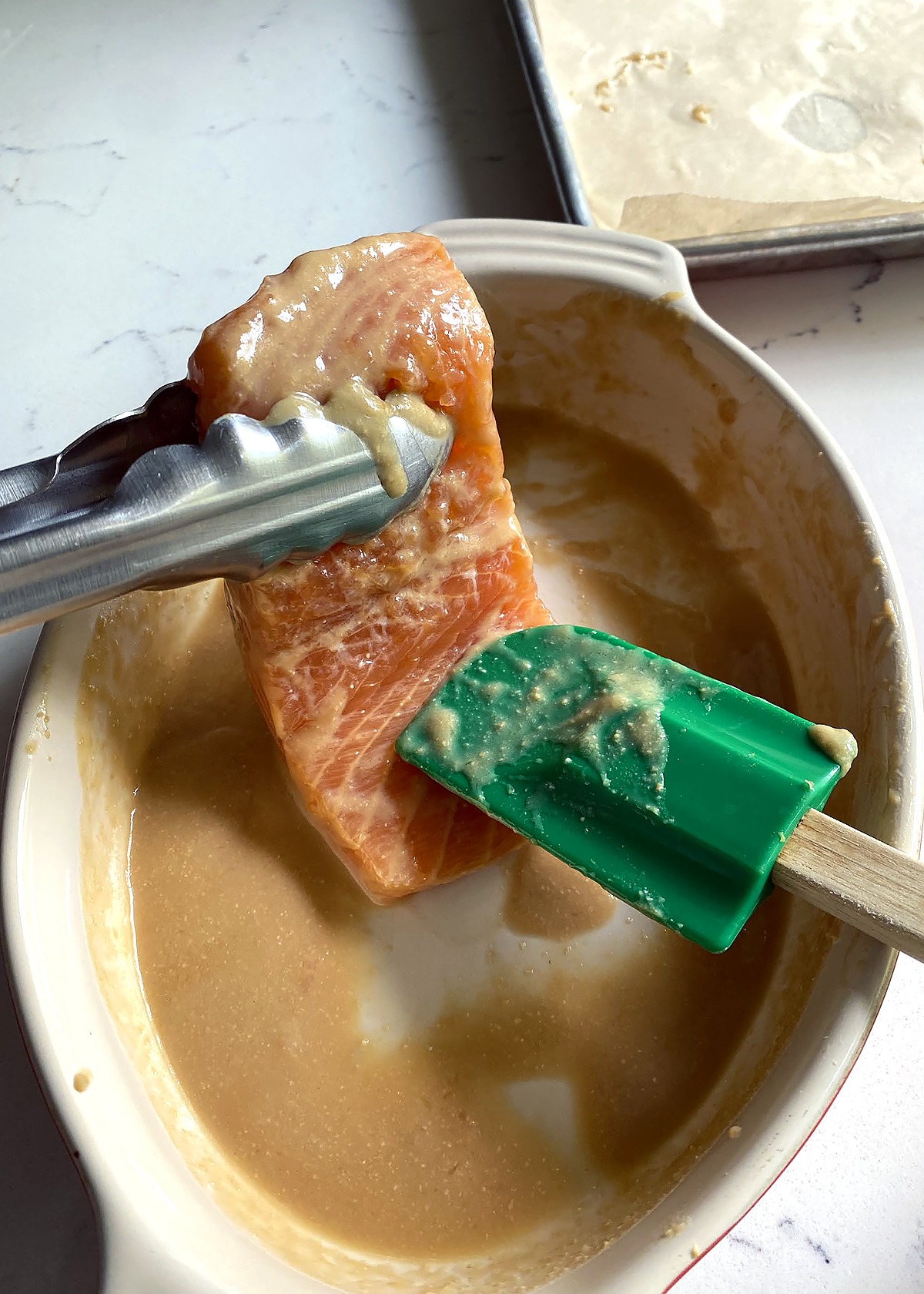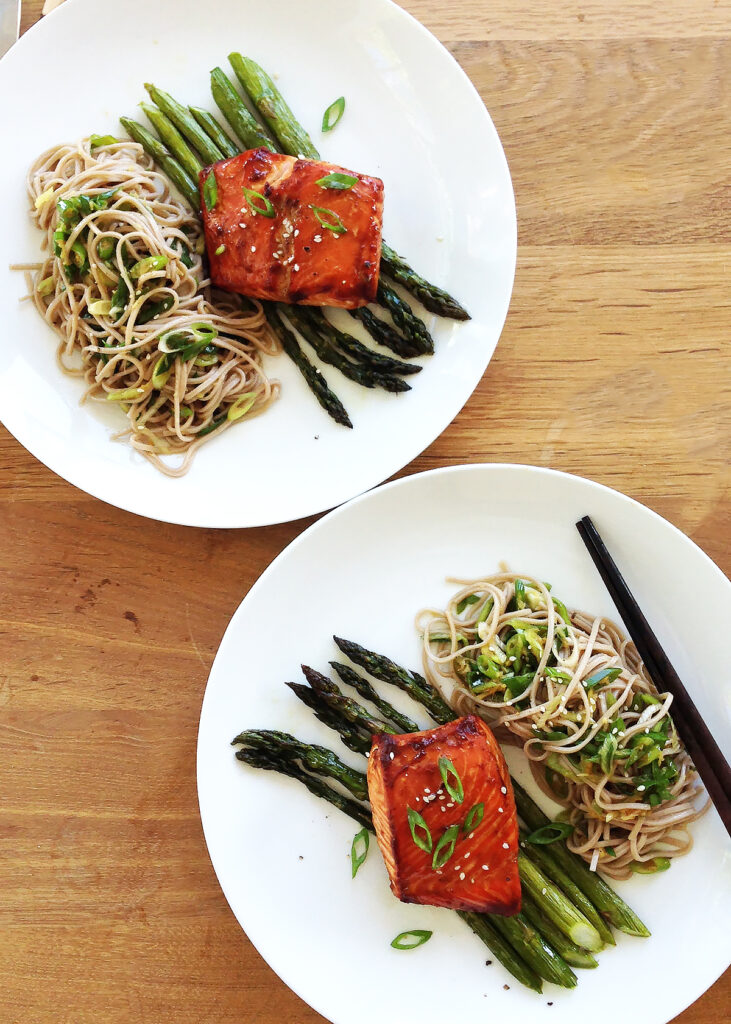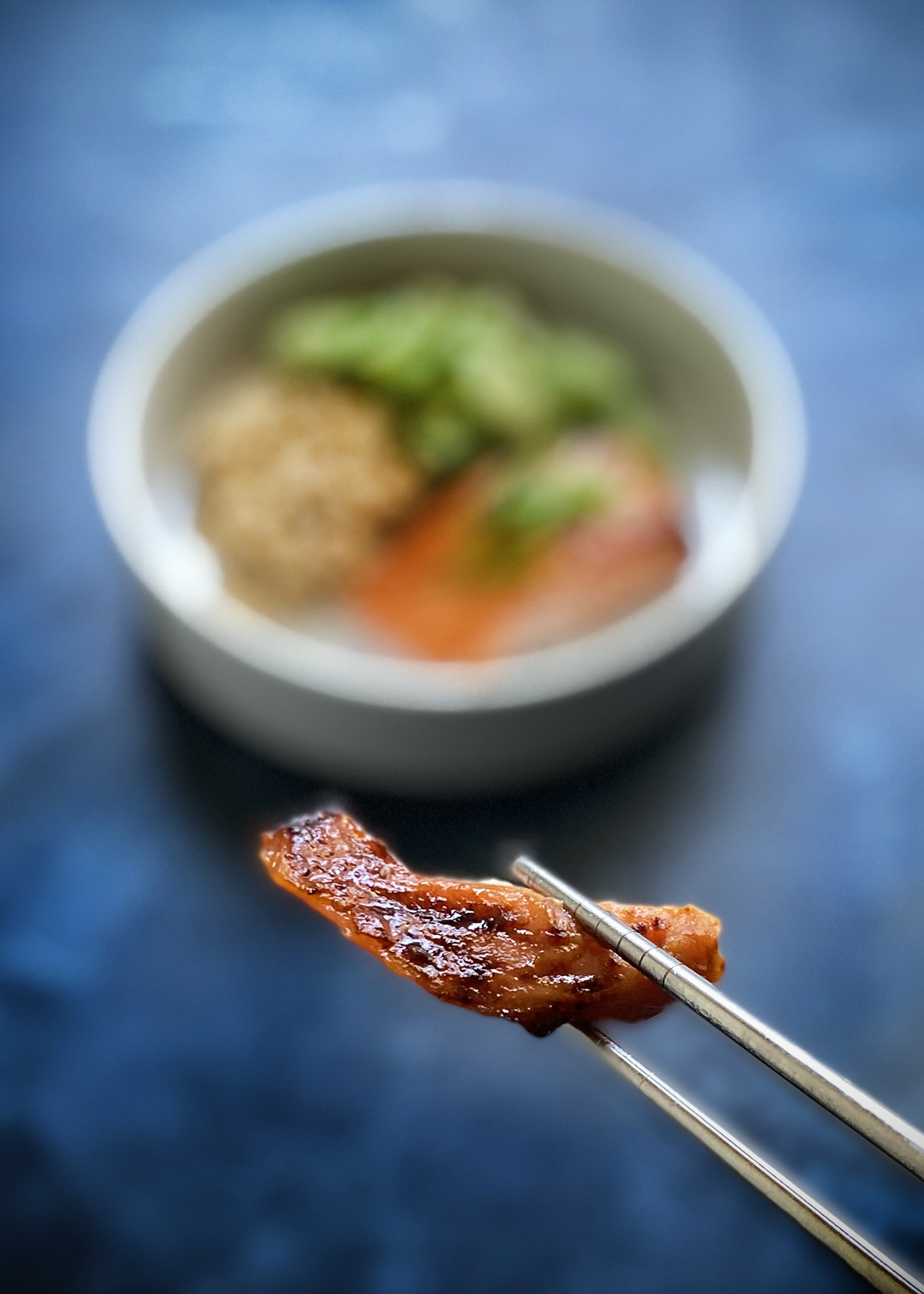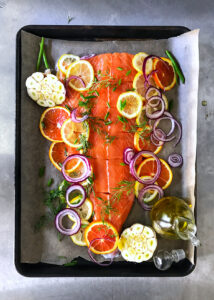This is the BEST Miso Salmon recipe because it has just a few easy-to-find ingredients, no refined sugar, and because we're using everyone's favorite fish salmon, super fast and healthy from frig to fork (or chopsticks)! Instructions for either the oven or an air-fryer! Shall we?

What is Miso Salmon | Health Benefits | Miso Salmon Ingredients | How to Make Miso Salmon | What Kind of Miso | What Kind of Salmon | Air Fryer vs Oven | Substitutions | Storing Leftovers | What to Serve with | Wine Pairing | RECIPE

What is Miso Salmon
Miso Salmon is salmon, usually in fillet form, that marinates in a salty, umami-rich miso mixture for a short period of time, then bakes in the oven or in an air-fryer.
You might already be familiar with miso-marinated fish, which is a classic Japanese preparation, made a little more world famous by Chef Nobu Matsuhisa's Miso Black Cod at his Nobu restaurants. Yeah, you know the one, with the charred edges and the little pickled ginger stem as garnish. His dish inspired my own recipe for Miso Marinated Cod here, which is a great alternative if you prefer a lighter, flaky white fish to richer fuller flavored salmon.
The marinade in this recipe for Miso Salmon is similar, but a little easier because it doesn't require mirin, a Japanese seasoned rice wine, and uses salmon, which is almost always universally available.
Health Benefits of Miso Salmon
Omega-3s in Salmon. When we talk about the health benefits of salmon, we are almost always talking about the health benefits of omega-3 fatty acids, the all-star anti-inflammatory compound associated with supporting gut health and reducing the risk of heart disease, diabetes, and other inflammation-induced diseases. Salmon is one of the highest concentration, highest quality sources of omega-3 fatty acids, containing 2,150 mg per 3-ounce serving.
Nutrients in Salmon. Salmon is also one of the most nutrient-dense foods in the world. In addition to the high levels of above-mentioned omega-3s, salmon is an excellent source of vitamin B12 for cellular energy, vitamin D which our bodies cannot make on our own, and the essential mineral selenium that has antioxidant properties that protect the heart, reduce cognitive decline, and boost immunity. (source: NIH)
Miso Has Probiotic-like Qualities. Miso is made by fermenting soybeans. As a fermented food, miso provides gut-health promoting probiotic bacteria. That fermentation gives miso its umami flavor, that salty, savory deliciousness that's hard to pinpoint in foods. Miso makes food taste delicious, so adding it to healthy foods like salmon helps you eat more of those healthy foods!
This recipe for Miso Salmon is:
- dairy-free
- gluten-free if you use tamari (which is naturally gluten-free) instead of soy sauce (which is brewed with wheat so it contains gluten)
- refined sugar-free
- low carb (though not keto, paleo, or Whole30 because the marinade contains both soy and sake, which is an alcohol)

What Ingredients You Need for Miso Salmon
For Miso Salmon, you will need only a few ingredients:
- Salmon, of course!
- Miso
- Sake
- Maple syrup
- Tamari (or soy sauce)
VIDEO: Watch How to Make Miso Salmon
Instructions for How to Make Miso Salmon

Pull any small pin bones from salmon fillets and remove scales if necessary. Rinse salmon and pat very dry with paper towels.

Whisk together miso, sake, maple syrup or other sweetener, and tamari in small bowl.

Marinade should have the consistency of a thin frosting.

Place salmon in glass or ceramic bowl and pour marinade over. Turn salmon pieces over in marinade to make sure all surfaces are coated. Cover and refrigerate for at least 30 minutes, up to 1 day.

Remove marinated salmon from refrigerator 15 minutes before cooking and let it sit on the countertop to get the "chill" off.

Lift salmon out of marinade and wipe off excess miso marinade. You can use a spatula or spoon to do this, or just use your hands. Do not rinse the salmon.

Place salmon fillet in basket of air-fryer OR on parchment-lined baking sheet, skin side down. Air-fry or bake in oven at 350° oven for 15 minutes.

Check for doneness. Salmon is cooked and ready when an instant read thermometer registers 145°F per USDA recommendations. You can also flake off a piece of salmon from the thickest part of the fillet and check for your preferred level of doneness. I like my salmon cooked all the way through.

What Kind of Miso Should I Use for Miso Salmon
tl;dr: Use any light-colored white or yellow miso that is labeled "organic" or "non-gmo." Light-colored miso, which I used throughout all the photos in this post, is also most commonly used in the Nobu Black Cod version of this recipe as well.
My favorite brands are all organic—this brand, this brand (pictured above), and this brand—and I have been able to find them in Whole Foods Markets in southern California. If you are able to get to an Asian market or specialty store, check out the miso section. It's huge! And you'll probably find these brands there too.
There are a few different types of miso that range in flavor, color, saltiness, and most importantly (to me) intensity of funk. No surprise here, but the funkier, the better. Miso can be labeled and categorized in a number of different ways, e.g. by ingredients, fermenting agent, city of origin, "style," but the easiest way for most people is to simply refer to the color.
Generally, the lighter in color the miso—those labeled "white" and "yellow," sometimes "shiro"—the milder the flavor and saltiness. Sometimes, the lighter colored misos are described as sweet, though they are not actually sweetened with any kind of sugar. They are just less salty.
Darker miso—labeled "red" or "aka miso"—is stronger in flavor and is usually saltier. I love darker red miso for soups and making dips for vegetables. Red miso definitely works for this recipe, especially since its stronger flavor stands up to the strong flavor and oiliness of salmon.

What Kind of Salmon for Miso Salmon
My salmon of choice is almost always wild-caught King salmon.
Check out this Guide to Salmon Types for full details on the what kind of salmon to buy for what kind of use, which salmon is healthiest, and why.
Wild-caught vs Farmed
For the health of both the oceans and yourself, wild-caught salmon as opposed to farmed salmon, is best for cooking. (Salmon for sushi is a different story entirely and deserves its own post.) Wild-caught salmon generally has fewer calories and less saturated fat, less harmful pollutants and contaminants, no added colors, and no question about the use of antibiotics, which is none.
King/Chinook vs Sockeye vs Coho vs Silver Salmon
King salmon, also called Chinook, is my personal favorite because it has a rich, buttery, silky texture. It also has the highest omega-3 fatty acid content of the different types.
Sockeye salmon, which is physically smaller and much deeper red in color, is my second choice for this recipe. It is leaner than King salmon, provides slightly more protein gram for gram, and has a more pronounced salmon flavor. The sockeye salmon's deeper red color comes from the antioxidant astaxanthin.
Coho and Silver salmon are the same variety! It is macro-nutritionally similar to sockeye salmon, but with a much milder flavor. I don't see this type of salmon often where I live.
When it comes to salmon, ask your fishmonger which one is best and freshest that day. that will always be your best bet.

Additional Ingredients Resources and Notes
- Sake. Sake, aka Japanese rice wine, is a type of alcohol made by fermenting rice. Just like regular wine made from grapes, sake comprises a wide variety of styles, brands, quality, and price points. As with any wine in cooking, use sake that you would be happy to drink. Sake is now fairly widely available in grocery stores in the wine section or in liquor stores. The organic sake pictured above is available here.
- Maple Syrup. Most Miso Marinades contain sugar, and quite a bit of it. I prefer the sweetness of natural maple syrup to refined sugars, and use a very little amount. I use an organic maple syrup like this.
- Tamari or Soy Sauce. Tamari is a Japanese-style soy sauce that is brewed without wheat so it is gluten-free. This is the brand I use, which is also organic. You can use regular soy sauce. If soy is not part of your diet, you can use salt, in about half the amount in the recipe.

Miso Salmon in Air Fryer vs Oven
I have made this recipe countless times in the regular oven and many times in the air fryer for the past year that I've actually owned one. I was an air-fryer denier for a long time, but needless to say, I finally caved and will never look back. Both methods have their slight advantages. Neither method has any disadvantages.
Air Fryer. If you already have an air fryer, use that to make this Miso Salmon for 2-4 servings, or whatever will actually fit in the air fryer. Because of the short cooking time and variability in thickness of the salmon even in an individual piece of fish, I have found the air fryer to be slightly more reliable in terms of final results. The air fryer also sort of automatically caramelizes the miso marinade without having an actual broiler function because the cooking space is so small.
Regular Oven. The oven is still the gold-standard for making Miso Salmon, of course, especially when making a larger number of servings. The broiler function on an oven also guarantees that you will get that slightly sweet, caramelized char on the miso glaze. Added bonus: you can cook your entire meal at the same time, just roast vegetables alongside the Miso Salmon int he same oven!
When I first started making Miso Salmon, I used to use a tiny little toaster oven because it seemed to wasteful to turn on the entire stove just to cook two or three pieces of fish. The toaster oven also had a "broil" function so it was easy to get that caramelized char on the fish. So if you live in a small space, you can still make this Miso Salmon!
Tools and Equipment
As I always say, you don't need any special equipment to make almost any recipe. However, that's not to say there are a couple of gadgets and tools that might make it a LOT easier to get Miso Salmon from your fridge to fork (or chopsticks).
- All-purpose 7-inch chef's knife to cut rolls in a single long stroke, rather than sawing back and forth, which will tear the nori and smash the roll.
- Large Cutting Board. A large size cutting board is stable, sturdy, and has enough surface area to prep multiple vegetables
- Glass mixing bowls
- Soy sauce dishes
- Stainless steel chopsticks
- Rice cooker. Rice cookers run the full gambit of types, features, and prices. I have two, this standard Japanese brand, and this fancy Korean brand, which the NYTimes loves. This is a smaller, affordable version of the Korean one.

Substitutions and Variations
With so few ingredients in this recipe, there aren't a lot of substitutions. That being said, you can make small adjustments to suit certain diets or lifestyles:
- Sugar-Free. To make Miso Salmon completely sugar-free, simply leave out the maple syrup or other natural sweetener. Miso, particularly white or "shiro" miso has an inherent natural sweetness, so you may not even miss the sugar anyway!
- Keto-Friendly. To make this Miso Salmon recipe keto-friendly, leave out the sake, which is an alcohol and not compliant with keto lifestyles. You do not have to substitute a different ingredients, though you may need to add a couple of tablespoons of water to get the right consistency. You can substitute in rice vinegar (keto-compliant) since the marinating time is fairly short for this recipe, though the flavor substitution is not 1:1 and the taste of vinegar is much stronger than sake. Use half to one-third the amount of sake, so for this recipe, 1-2 tablespoons of rice vinegar.
- Other Fish for Miso Marinade. You can absolutely substitute other fish for salmon in this recipe. In fact, the inspiration for this dish was originally made with black cod/sablefish, from Chef Nobu Matsuhisa. Some great substitutions for the salmon are: black cod aka sablefish, regular cod, and sea bass. Because these fish have a much milder natural flavor than salmon, marinate the fish for longer (up to 3 days!) to really amp the flavor.

Leftovers and Storage
Marinated raw Miso Salmon should be cooked within one day of marinating.
Refrigerator. Cooked Miso Salmon can be stored in an airtight container in the refrigerator for up to three days. Refer to the USDA for safe storage information for fish.
Freezer. Freeze and store cooked Miso Salmon in an airtight container, preferably with the air removed like in a zipper plastic bag, in the freezer for up to 3 months. Refer to the USDA for safe storage of fish and shellfish.

What to Serve with Miso Salmon
A generous serving of omega-3-rich salmon marinated in gut-healthy fermented miso served with brown rice and a green vegetable is a perfect meal to me! Here are some great suggestions to pair with:
- Spicy Cucumber and Avocado Salad
- Garlicky Korean Spinach
- Thomas Keller's Oven Roasted Zucchini with my miso glaze
- Steamed Asparagus
- Soba Noodles
- Edamame in their pods
Wine Pairing for Miso Salmon
The most obvious pairing choice here is sake, since sake is part of the miso marinade! But don't drink the sake you used for the marinade, as you should be using a good affordable sake for cooking and a separate GREAT sake for drinking.
Because sake is made via fermentation, it is sometimes described as "rice wine" because it is made by fermenting rice, like regular wine is made by fermenting grapes. However, sake is a totally different category of alcohol because the flavor and experience are nothing like regular wine.
If you'd like to stick with regular wine for pairing with Miso Salmon, focus on the flavor that dictates the wine pairing: prominent sweetness.
Miso-flavored dishes are:
- sweet
- sweet
- did I say sweet already
- sometimes salty and/or spicy
and do best with wines that are:
- medium-bodied
- high acid
- low tannin
Try these specific wines:
- Dry Riesling, try Tatomer 'Steinhügel' Riesling', Santa Lucia Highlands. Tatomer is a Riesling specialist in Santa Barbara, and makes this special Riesling from a biodynamic vineyard in Monterey. Multiple vintages of Tatomer Riesling available here.
- Pinot Gris (same grape as Pinot Grigio), try La Crema Pinot Gris, Monterey La Crema is a widely available brand based north of Monterey in Sonoma, but this particular wine is made with grapes grown in Monterey!
- Gewürztraminer, try Scheid Vineyards Gewürztraminer
- Dry rosé
These wine pairings will more than likely work for salmon glazed or coated with any type of sweetness including brown sugar, maple syrup, honey, reduced fruit juice, etc. For more comprehensive guide to the best wines to pair with salmon, check out this post, which has specific bottle recommendations.

Add these Salmon Recipes to Your Repertoire
Yes, we are obsessed with omega-3-rich salmon in this house, why do you ask?
- Spicy Gochujang Salmon
- Salmon Bibimbap a great use for leftover Miso Salmon
- Salmon Bulgogi with Ssam Lettuce Wraps
- Grilled Salmon with Cherry Salsa
- Citrus Baked Salmon one of the MOST MADE recipes from this blog
- Salmon Puttanesca in a rich, super flavorful tomato sauce
- Salmon Piccata with lemon and capers
- Salmon with Olive Salsa Verde
What Else to Make with Miso? Try These:
Since you only need ¼ cup of miso for your Miso Salmon, you'll have an entire of container of miso left to make these recipes!
- Miso Ginger Dressing makes ANY salad craveable
- Miso Roasted Brussels Sprouts
- Ginger Miso Soba Noodle Soup
- Miso Butter on Poached Eggs
Miso Salmon
Ingredients
- 2 6-8 ounce fillets salmon any kind, see notes for details
- ¼ cup miso any kind, see notes for details
- ¼ cup sake, aka Japanese rice wine
- 1-4 tablespoons maple syrup
- 1 tablespoon tamari or soy sauce
- optional for garnish: sliced green onions, toasted sesame seeds
Instructions
Marinate Salmon
- Rinse salmon, dry off thoroughly with paper towels, and remove scales if necessary. Place in a glass or non-reactive container, preferable if it has a tight-fitting lid.
- Whisk together miso, sake, maple syrup, and tamari in a small bowl until thoroughly combined. Miso has a slightly grainy texture so the marinade will not be completely smooth.
- Pour the miso marinade over the salmon in the container. Turn over the salmon fillets in the miso marinade to make sure all side are coated. Spoon some of the miso marinade over the top to make sure there is a layer sitting on the top surface. Cover the container, place in refrigerator, and marinate for at least 30 minutes, up to two days.
Bake Salmon in Oven
- Heat oven to 350°F. Line baking sheet with parchment paper. Remove salmon in miso marinade from refrigerator, best if 30 minutes before cooking to allow salmon to take some of the chill off.
- Lift salmon fillets from marinade, gently wiping off excess marinade from the salmon. ** Do not rinse ** You want to leave a thin layer of marinade on the surfaces of the salmon.
- Bake the salmon for 15 minutes, then check for your preferred level of "donenes.." Because salmon fillet thickness varies so much, the best way to check if the salmon is done is to use an instant-read thermometer. For medium rare which is still raw/fresh in the center, aim for 120°F. The USDA recommends cooking fish to an internal temperature of 145°F. You can also just flake off a piece of salmon from the center of the fillet to see if it's cooked through to your preference.
Optional: Broil Salmon for Burnt "Char"
- If you want a little bit of char on the salmon, turn the broiler to high in your oven. Place the cooked Miso Salmon under the broiler for 3-5 minutes until the edges have developed a char. ** Do not leave the kitchen during the broil step, do not leave the oven, in fact you should stand right in front of the oven and watch the salmon until you remove it from the oven. Miso marinade burns easily because of the sugar and you definitely don't want to waste a perfect piece of salmon! I share from experience.
Why Trust The Delicious Life?
Sarah is a professional recipe developer, writer, editor, and digital content creator with almost 20 years of experience cooking both at home and in professional kitchens, entertaining, and catering for private clients. She studied Nutritional Science in college and promotes happy healthy living through food.










Scott says
Swaps for maple syrup? Would honey or agave work?
Sarah J. Gim says
absolutely honey and agave are great substitutes for the maple syrup! (you can even use plain ol' white sugar if you have it ;D )
April says
I don’t see any notes under the “What Kind of Miso Should I Use for Miso Salmon” and “What Kind of Salmon for Miso Salmon” headings. Is it just not loading for me, or are they missing?
Also the cooking instructions in the notes say 350° in air fryer or oven, but the recipe says 400° in oven. Did you mean 350° for an air fryer or an “air fryer oven” (the toaster oven shaped ones), vs 400° in a full size oven? Or are they supposed to be the same temp regardless because you meant a full size oven both times and it’s a numerical typo? I’d appreciate the clarification!
Thanks for your help!
Sarah J. Gim says
April! THANK YOU so much for the catch! It's 350°F for both! Immediate edit to the recipe made!
Looking into why those two sections are missing from the text BUT... long story short while I sort that out:
1) Use an organic white (milder) or red (saltier) miso
2) I always encourage buying and eating wild king salmon (sometimes called "chinook") which is moderate in flavor, more luxurious/silky texture!
thanks again